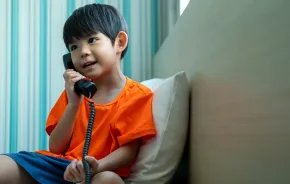

The mission statement of Seahurst Elementary School in Burien is certainly an apt one for the times we’re living in: Educating Students for Success in a Changing World. Given the current pandemic-beset state of our world, “changing” is a bit of an understatement. Terry Holtgraves has served as principal of the school since 2017. If there is a silver lining to the dislocating impacts of COVID-19 on education, she says it’s that “from university to preschool, everything is being rethought — from chaos comes opportunity.”
We caught up with Holtgraves to hear more about the principle — and principal — lessons she’s learned over the months of distance learning and how she’s thinking about the future opportunities of her staff and students.
Digital access for families is one of the most complex issues facing schools today — has technology access been a significant challenge for your school community?
To tell you the truth, meeting our families at their homes is the method that really has had the most impact. About 40 to 50 percent of our families live in the same large apartment complex. We were instrumental in getting food served at the complex because our families were having trouble accessing food. So, once we had a food source there, then I could show up at mealtime and make a lot more in-person contacts. Of course, always social-distancing, wearing gloves and masks. But the in-person contact proved to be really key. A lot of our families would run out of minutes on their cell phones, for example, and they didn’t have email. In-person meetings really helped to bridge some of the access gap.
What has inspired you as you’ve dealt with the endless challenges posed by the pandemic?
I’m very inspired by our teachers. Some of them set up little makeshift classrooms in their home, complete with whiteboards and charts. I got to know all of their dining rooms and the variety of spaces where they operated. It’s a big risk to learn to videotape yourself. That’s not something that we’re trained to do — it can be very uncomfortable. All of this while they were learning to utilize many platforms to effectively convey quality lessons to our kids. So, my staff and my teachers are my heroes.
Of course, parents are also the heroes of this pandemic. Not only were they thrown into a pandemic that affected them economically, they were getting sick themselves. They were losing jobs. Some of them had jobs and had to figure out, “How am I going to get my job completed?” Many parents are not digitally savvy but they are doing their best to support their children while working in these most challenging of times. My heart goes out to them, because they’re learning all of this technology right along with the rest of us.
How about your students?
I’m always inspired by our kids and by their levels of resilience. Any time I was able to go to their apartments and be available to deliver meals, educational packets or technology, they were always so excited to see me and the other staff members who were able to visit with them.
But I do feel that these kids have experienced trauma. And neither we nor they can fully appreciate the extent of it. And we may not for a very long time. They were pulled away from everything that was familiar and consistent to them. What we were able to provide online in no way replicated what these kids were used to. And I think we haven’t even touched the tip of how this is going to affect them in the long run.
How has the murder of George Floyd and the Black Lives Matter movement influenced or informed your leadership?
All the protests for social justice that we’ve seen going on have given me more hope than ever. Our attention spans are very short — we see this happen again and again, and then we just go back to life as normal. But this time, I think the intersection of a lot of people having more flexibility in their schedules, being able to go out and be relentless day after day to protest and write to their congressional representatives, and to use their voice, gives me more hope than I have had before. This is really going to be a turning point.
I think it has affected how I’m going to lead and what my staff is going to be doing when the fall comes. We have a lot to do to educate ourselves. We were educated in a white culture that is so pervasive that it’s difficult to even see the racial inequity — we’re just marinating in this culture. We need to have our eyes opened and be ready to learn as much as we can. We’re going to be devoting significantly more of our professional learning to equity, social justice and understanding race.
We have adopted the Teaching Tolerance Social Justice Standards. I was able to share those with staff several times during remote learning, but I know that their attention was completely diverted by this huge task that they had. So, one more time at the close of the year I told them that it is our job this summer to read and understand these standards so that we can adequately teach social studies to our kids.
When you say social justice standards, can you give an example of what that would look like to a teacher?
Although we strive for all people to be created equal, that’s not the current reality. I think that getting teachers comfortable with recognizing that as white educators we have different experiences than our students and our families do and just calling that out as blatantly as we can is [critically important]. It is what we have to do to move forward as Americans: teach kids that things are not equal right now. Here’s how you as a student can have an effect. You can write letters. You can have a voice. You can make videos. We can hold these discussions to really move forward and do better.
How do you try to ensure that your educational team reflects the student body?
Unfortunately, right now, our teaching staff does not reflect our community. That is extremely important, not just for our students. I’ve seen the positive impact on kids when we are able to hire people of color. It doesn’t just make a difference to our students and families, it enriches us as a staff. We’re gaining new skills, new perspectives and new information, and that’s critically important. Our student body is approximately 60 percent Latinx, 8 percent Black, 10 percent Asian, 5 percent Pacific Islander and Native American, and 15 percent white; and yet, our staff is 74 percent white.
I’ve heard across the board that 80 to 85 percent of our teachers nationwide are white. If that is true, we’re right in line with that. In three years, I’ve had 16 open positions and I’ve been able to hire seven people of color. So, we’re making up some ground. When I have an opening, the contract specifies that principals have to take any staff with seniority across the entire district to fill positions before I’m allowed to post and interview for them. Principals, in my district at least — and I am guessing this is fairly widespread — do not have autonomy to post positions and hire at our building level.
Until we can come to an agreement that affirmative action is a good thing, that we need to have more autonomy at the local level to ensure that our teaching staff in each building looks like our children, until we can get agreement on that widespread and really negotiate those contracts to be different, we’re a little bit held hostage.
But I am acutely aware that I can’t offload responsibility and say, “Well, there’s nothing I can do. This is just district protocol.” I realize that there are things I can do when I am lucky enough to be able to hire persons of color. As a white principal, I have the responsibility to ensure that their voices are heard and uplifted, that they thrive in my school environment, that they are being promoted and given access to different opportunities. I know I play a role, but I have also been extremely frustrated by the lack of autonomy that I do have.
What would you want to say to the public about funding for education?
I would just ask our federal and our state governments to really take a long, hard look at funding for our schools. Just like we’re looking at reallocating the money that we put into our police force into more preventative measures, our school system has got to be key in our success as a country moving forward.
Any message for your students and parents about the summer and going back to school?
Thank you so much for your resilience! Thank you for all of the support that you have shown, for your stamina and your growth mindset at this time. Secondly, my “ask” of students would be to just try and chip away at closing some of that time that you weren’t able to fit in during the year. Get online and continue that learning and that reading this summer as much as possible.
What have you learned about yourself during this pandemic?
Well, that’s a difficult question because I haven’t really had time to process what I’ve learned. But I’ve learned a lot! I’m obviously more tech-savvy than I was before the pandemic. I’m better able now to reach out to my families. I know intimately where they live. I’ve been to their homes. I also feel much more confident than I ever was before that I’m going to be able to lead a staff and navigate these challenging times.











